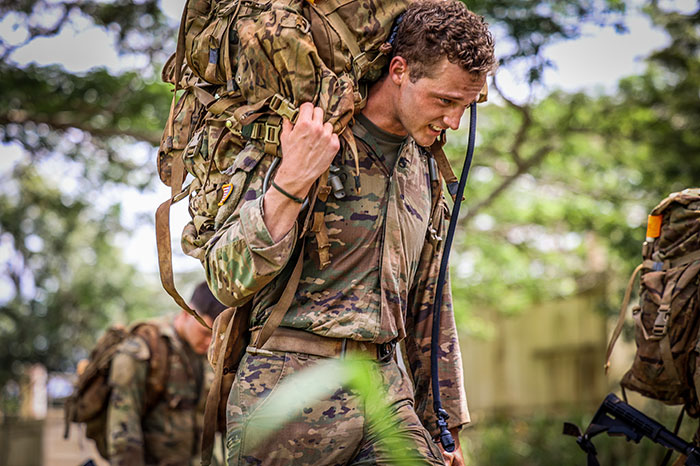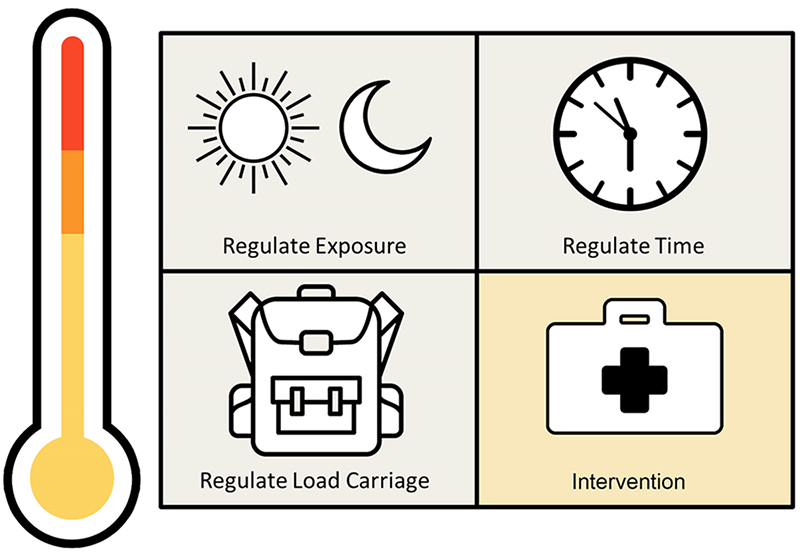Armed Forces Work to Adapt to A Changing Climate

Rivulets of sweat dripped down the Soldiers' flushed faces as they marched across the arid land mid-summer. As temperatures rise to over 100°F, the humid air becomes oppressive and heat-related illnesses become an increasingly real threat to Warfighters. Extreme temperatures and intensifying weather, influenced by a warming climate, continue to get worse or at best sustained, becoming a perfect recipe for noncombat-related injuries.
Climate change is not a new phenomenon but is one that continues to not only affect the ecosystem—plants, animals and resources—but also Army operations. Like a pendulum, temperatures oscillate between hot and cold, which is normal, but can be amplified to more extreme levels."It is hard to ignore climate change when it has real world effects, as it directly impedes how we conduct military operations or training," said Dr. Adam Potter, Research Physiologist in the Thermal & Mountain Medicine Division (TMMD) at the U.S. Army Research Institute of Environmental Medicine (USARIEM). "It poses increasing risks to the health of Service Members and has the potential to jeopardize our missions."
Heat-related illnesses and injuries can take a Warfighter out of operations during both training and in real-world military activities, such as combat, security operations and humanitarian missions. With increasing environmental temperatures, Warfighters might find themselves facing exertional heat illness that can range from heat exhaustion to life-threatening heat stroke. This risk increases during strenuous operations such as foot marches, running activities or when carrying heavy loads.
"When carrying out military-specific tasks, such as the 2-mile run or 12-mile foot march, often carrying heavy packs, the chances for an individual to reach a dangerous level of body core temperature, or hyperthermia, increases greatly in higher ambient temperatures, especially if clothing or high humidity prevent the evaporation of sweat," said Dr. Nisha Charkoudian, Chief of TMMD. "In a practical sense, standard military training becomes progressively more thermally stressful compared with just a few decades ago."
Military Training and Operations in the Era of Global Warming

To predict the potential impacts from environmental exposures, such as increased temperature or humidity, the Army has developed sophisticated biophysical mathematical models. "Typically, we need to consider a minimum of four factors in our modeling, including the environment, the human — fitness, body size, etc. — their activity level and the clothing they are wearing," Potter says. "We can put quantifiable numbers to each of these elements and mathematically describe or predict likely changes to occur in a given scenario to a human and their physiological and/or thermal responses."
These models enable Potter and other researchers to calculate the differences in exposure risks between individuals based on their size, acclimation status and health status. If there are shifts in the environment, these models allow for data-informed comparisons to suggest how sudden changes can impact the individuals or groups. The relative risk of heat stress of a Service Member could be assessed based on the combination of conditions and their specific clothing. For example, a full combat uniform could be removed, or items worn could be adjusted to decrease the thermal burden on the individual.
Some environmental conditions the model accounts for include elements such as solar radiation, wind velocity, humidity and temperature. These factors can drastically change and may force Soldiers to adjust their training. For example, conditions could be shifted to nighttime when there is little to no solar radiation compared to during the day.
"With an increase in a temperature alone, there becomes an increased risk to individuals that may shorten the amount of time they may safely work in a given condition. While individual differences can also be modeled; where, for example, in some conditions, a person of a smaller size will be better off in one condition than another and vice versa. The models provide us with powerful tools, as they allow us to assess the complex interactions of all these different variables," Potter said.
The military has procedures for training, tactics and operations, but the climate can be an additional adversary or ally depending on the Army's approach. Charkoudian and Potter suggest that the military implement creative or "outside the box" methods to adapting to a changing climate.
"One approach may be to investigate potential impacts of a reversal of sleep-wake cycles during basic training during the hot months of the year, to minimize the usual increase in heat-related injuries, and to enhance the capacity for physical training and combat performance," Charkoudian said. "Switching day and night could decrease both heat-related illness/injury and lost training days over the course of the basic training program. However, this approach would have multiple ramifications regarding Soldier health and logistics of training, so the feasibility remains to be determined."
"It can be difficult to implement a systemic shift, but it could be necessary if the risks of heat injuries are so high that they result in heat casualties," Potter said. "It could even be a tactical advantage to doing operations at night."
This kind of shift in structure could provide us with both physiological and tactical advantages but may result in unconventional alterations.
"We recognize that there would be multiple effects of such a modification and data collection would be necessary to evaluate the effects of these types of changes, such as inverted sleep-wake schedule on physical and mental health and on physiological and cognitive performance," Charkoudian said.
Solutions for a warming climate will not be found overnight, but in the meantime, the Army is finding revolutionary ways to adapt to an unpredictable and modifiable environment.
"Climate change is a threat, but we can also use it to our advantage by changing traditional military operations for new recruits and mitigating health threats that reduce military readiness," Potter said.
USARIEM is a subordinate command of the U.S. Army Medical Research and Development Command under the Army Futures Command. USARIEM is internationally recognized as the DOD's premier laboratory for Warfighter health and performance research and focuses on environmental medicine, physiology, physical and cognitive performance, and nutrition research. Located at the Natick Soldier Systems Center in Natick, Massachusetts, USARIEM's mission is to optimize Warfighter health and performance through biomedical research.













